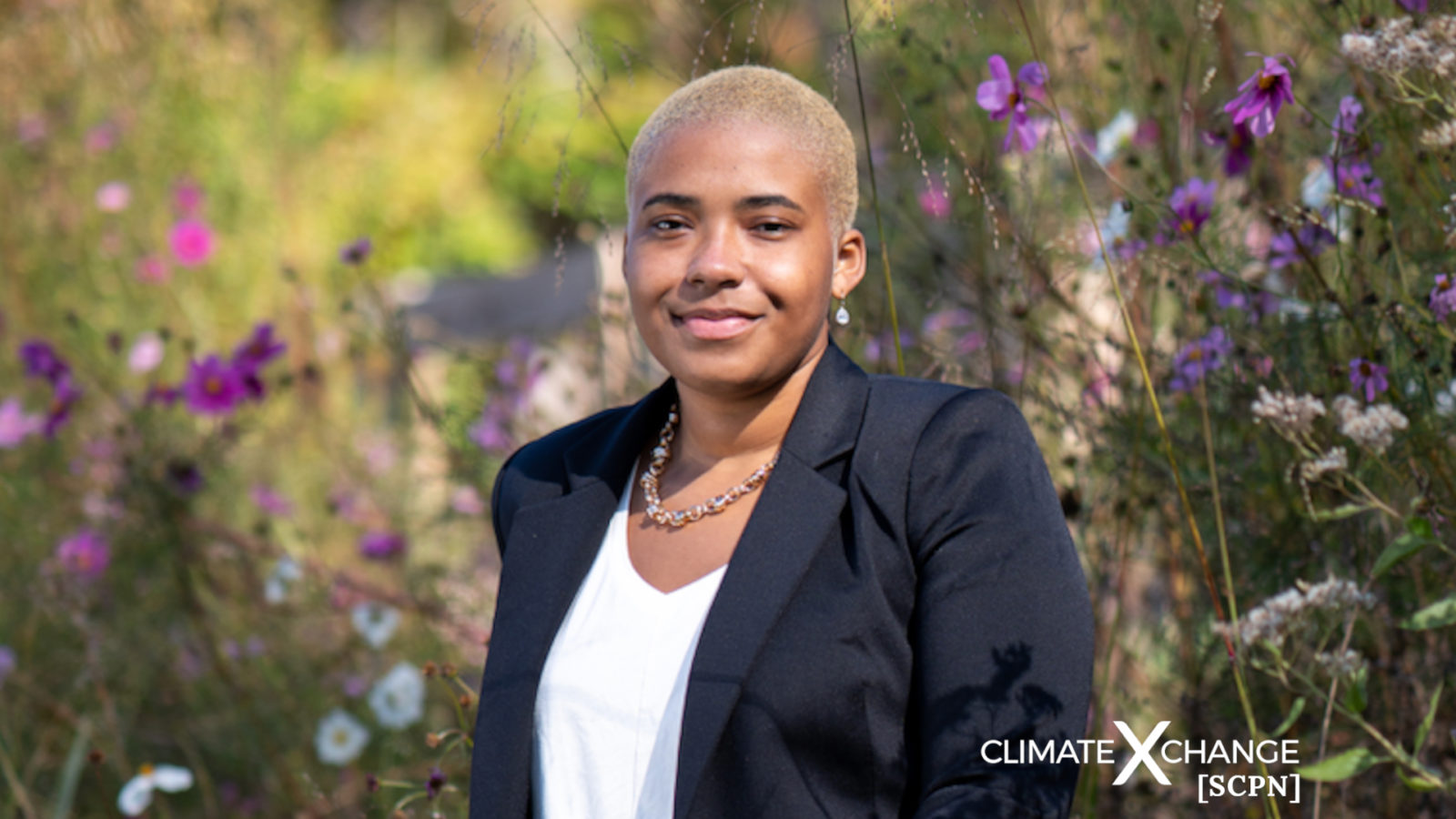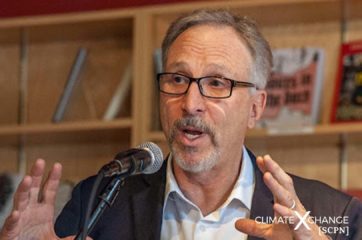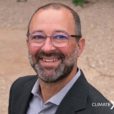All across the country, members of our State Climate Policy Network (SCPN) are fighting to make an impact on climate change in their communities. We have individuals in our Network from all 50 states, each experiencing climate change differently in their local areas and finding unique solutions to build resiliency efforts.
McKenna Dunbar is a clean energy and environmental justice advocate, and a junior at the University of Richmond. They are currently working as a Community Engagement Coordinator with the Sierra Club while studying Business Administration and Environmental Studies. Dunbar founded the Ecological Justice Initiative to connect young people with resources and opportunities in the environmental justice space.
Izzy Hamilton: Can you tell me a little bit about your background and how you initially got involved in the climate space?
McKenna Dunbar: I didn’t originally start wanting to dedicate my career towards renewable energy and infrastructure. I was originally a biochemistry major who wanted to pursue a career as an intellectual property attorney. I wanted to work with biotech firms and that sphere. In my freshman year of college at University of Richmond, I took a Mesoamerican Ethnobotany course that introduced me to the customs, traditions, and taxonomy of plant species in Mesoamerica. From there, I got more involved with environmental spaces. I’ve always liked gardening, and I’ve always liked being outdoors. Because of that, I wanted to get more engaged with the environmental sector. So I spoke with Dr. John Hayden, a professor of biology specializing in the anatomy, morphology, and systematics of vascular plants, and he allowed me to have more opportunities with herbarium research focused on moss and lichens. Now, I’m studying myxomycete species and working in the greenhouse more.
I started there, but I’ve always been interested in racial justice and social justice. I wanted to see how I could combine both my interests: protecting our natural landscape and thinking about topics that focus on Black, Brown and Indigenous communities. So I started reading into the intersections of these spaces and I found out that there was a term called environmental justice. I learned more about that and realized that there was a professor at the University of Richmond who specialized in it, Dr. Mary Finley Brook. She’s an acclaimed environmental advocate and professor of geography and the environment, as well as a general leader in the field, specifically advocating against fossil fuel developments in marginalized populations. So I reached out to her. After a while, we began to talk and she basically took me on as a mentee, and that was right before COVID happened in February or March of 2020.
After that, I began to get involved with Bridging the Gap in Virginia, which is a nonprofit organization focused on green workforce development, training, and providing resources to combat recidivism, homelessness, poverty, and other social disparities. My interests were supported by my mentors Dr. Hayden and Dr. Finley-Brook, and wonderful individuals who were part of my university community like Dr. Katrina Nousek, Dr. Stephanie Spera, Dr. Todd Lookingbill, and Dr. David Kitchen. Educators like them are a fundamental reason why I have been able to explore interdisciplinary climate studies and environmental topics in so much depth.
Izzy Hamilton: What inspired you to start the Ecological Justice Initiative (EJI), and what kind of work has your organization been doing?
McKenna Dunbar: I founded the nonprofit in November of 2020 because I noticed that I was one of the only young people in the room when it came to conversations surrounding climate equity, renewable energy, and decision making processes to promote a more sustainable world. I have been given great guidance by a number of professionals in the renewable energy and climate sectors, but not many of them looked like me, and none of them were my age.
I really wanted to create an organization that acted as an opportunity pipeline so students, whether they are in middle school, high school, or even graduate students, have a community where they can connect with other organizations, and they can hone their research and environmental engagement skills with the EJI. Then they can use that as a catalyst to connect and network with environmental organizations like Concerned Citizens of Charles County, one of the original environmental focused nonprofits I started working with, Bridging the Gap in Virginia, Stop the Abuse of Virginia Energy Coalition, Mothers out Front, and Appalachian Voices, among others. There are so many organizations that students know about because of the EJI and hopefully future interns, fellows, and members of EJI have the opportunity to reach out to these organizations, be a part of EJI’s research community, and learn more about their passions.
For example, a few weeks ago I co-hosted an event at Virginia Commonwealth University for their climate summit called “Climate Emergency, Now What?” Five EJI interns came and presented the different types of research that they’ve been investigating since January of this year. We had one intern, Julia Berutti, who’s focused on environmental migrants, like climate refugees. Specifically, how that’s a growing large-scale social disparity that is occurring in communities that are facing the worst impacts of the climate crisis. We also have Adam Webster, who’s focused on carbon offset policies in the corporate sector, and Patricia Ramsay, who’s focused on ecological degradation in Florida’s wetlands as a result of agriculture. Bianca Carey, EJI’s public health and equity fellow, spoke about more regional topics related to the lifespan variations between Richmond racial groups as a result of social inequities. Indya Woodfolk wrote an impactful piece on the expansive energy audit work that she and I carried out in Portsmouth, VA earlier this year. We even had the work of our artists in residence, Megan Maybee, Casey Murano, and Bailey Santaguida, at EJI showcase their art focused on geography and different interpretations of climate.
So not only have we done that, but we as EJI have different sectors that focus on research, analysis, grants and fellowships, and environmental law and policy. There’s even a social media and web management group. You don’t have to be an environmental major – I wasn’t originally planning on being an environmental major, but now I am. We have majors in history, engineering, anthropology, political science, and we explore the ways that your interests and academic passions can intersect with the environment and become something fruitful.
Izzy Hamilton: In the climate crisis and environmental justice conversation, what are young people bringing that was lacking beforehand?
McKenna Dunbar: I see youth as a driving force in the future of climate conversations, especially in fostering an environment that is rooted in sustainability and equity. That is something that really needs to be emphasized, which has not been emphasized enough in the past. It’s just because climate change, as we know, is a global phenomenon that is rooted by scale and time. The way I see youth being integrated in climate conversations and conversations surrounding renewable energy is especially in grassroots organizing, because the youth have power, especially with social media, mobilizing, interacting, and really highlighting work. That kind of work has the capacity to change the world since it adds perspectives on climate and the importance of protecting vulnerable people and places.
In the past, these have not necessarily been highlighted in the best ways, whether it be through campaigns, online sources, or even through the general media. With the skills that youth have in this day and age, these topics can be propelled into something greater and something that more audiences can hear. Then other young people can see someone who looks like them in climate conversations. That’s why I think that diversity, both in thought and in background, is super important with having conversations and changing perspectives on the communities that are impacted by climate change. How can we go into a net-zero future? Why is renewable energy important? And how can everyday civilians around the world be a part of this conversation?
Izzy Hamilton: Can you tell me about the work you’re doing with the Sierra Club?
McKenna Dunbar: Yeah, of course. This is the start of my second week, so I am early in my position. As Community Engagement Coordinator and Building Electrification Lead, my job is to mobilize and advocate for a clean energy future. I lead a team that’s focused on building and home electrification. I’m focused on decarbonizing our energy grid through developing and analyzing policy about net-zero technologies, the climate sector, electricity generation, and building codes.
I also use legislative bandwidth and community organizing to drive innovation and improvements in energy systems and health and safety upgrades in homes and schools. I inform the public on the importance of clean and accessible energy, especially with solar and wind development. As many of us know, solar and wind are the cheapest forms of electricity that we have available today, and we do not use them enough. Solar presently costs six cents and wind costs ten cents per kilowatt hour. These are technologies that will not only improve the competitiveness of our supply chains, but also increase renewable energy resiliency, lower energy burdens on communities, and create sustainable economies of scale.
Izzy Hamilton: That’s really important work, thank you for sharing. I’m curious where you see the state of Virginia in the environmental justice conversation, and what you think the state’s top priorities should be to promote environmental justice and correct past injustices.
McKenna Dunbar: I would like to emphasize that I think one of the main priorities that the state should venture into is the shutdown of gas plants, pipelines, and export terminals of natural gas and fossil fuel resources in the state. For example, we have five gas plants in Virginia. I’m currently in Richmond and these are all within a two hour driving distance of me, and these developments are concentrated in rural central Virginian localities.
There’s the Chesterfield electric generation power plant, the Charles City power project, Chikahominy power, Gilmerton energy center, and then there’s the cogeneration facility at the Naval Station in Norfolk. I have direct experience in fighting the coal power station in Charles City County. That’s where the focus of my work for Concerned Citizens of Charles City County has been for the past year and a half. New fracked gas infrastructure locks our nation, and the state of Virginia, into a fossil fuel commitment for the coming decades This is problematic because it slows progress in the clean energy transition while degrading public health and equity, as well as environmental protection. It leaves vulnerable communities at risk and with heightened energy demands. We need that to come from clean energy, not fossil fuel infrastructure.
So I personally want to see a push for better policies and purchases on the national level, but specifically for Virginia to fund statewide projects that emphasize environmental justice frameworks in regulatory decisions. Energy regulators and commissioners need to integrate environmental justice tenets in their decision making processes, because we all know it is cheaper to protect our environment than to destroy it. To preserve our environment and revitalize our economy, Virginia needs to focus to get halfway to net zero by 2030. We’ve already needed to start reducing our emissions by 10 percent every year, since last year, and that has not happened. The main priority needs to be the clean energy transition going from fossil fuel based technologies to renewable ones and emphasizing marginalized communities, specifically the low income Black, Brown, and Indigenous communities in the conversation.
The way I see this is through environmental justice. I like to split it into three components in order for audiences to better understand. There’s representative justice, which is basically the way in which marginalized communities are represented in decision making processes in order to correct inequities fueled by fossil fuel developments and environmental degradation activities that impact the community at large. There’s distributive justice, which grounds itself on the foundation of equity, making sure that no one in an impacted community has a disproportionate burden with whatever degradation is occurring. And then there’s also procedural justice, which means making platforms fair and accessible for communities to state their desired wants and needs related to environmental decision making.
Izzy Hamilton: I really appreciate hearing your perspective today. And just want to make sure if there’s anything else you’d like to speak on that you have the opportunity to do so.
McKenna Dunbar: I consider my passions to be mobilizing and inspiring grassroots activism and communities that are typically left out of the conversations that directly impact their livelihoods, and providing platforms and resources is at the center of the work that I do. I plan on doing that in the future as a clean energy professional. I also believe that energy regulators and electricity regulators need to demand cleaner sources of electricity. There’s a lot of stagnation in the regulatory and policy decision making fields because there are numerous stakeholders at play in the fossil fuel industry. There’s a lot of money being made and a lot of companies and corporations benefiting from those financial resources. This is why there are additional planned fossil fuel infrastructures, specifically gas plants. There’s no reason that these infrastructures need to be planned, especially if the state is committed to a 100 percent clean energy future that is bolstered by the Virginia Clean Economy Act and the Biden-Harris administration’s Build Back Better Act.
There’s not enough thorough consideration for the environments that are being polluted. 75 percent of emissions come from the 20 largest emitting countries; the number one contributor to those emissions comes from the energy grid. Number two is transportation, number three is buildings and number four comes from industry. Because we are in an industrialized economy that relies on carbon dioxide, we really need to make a concentrated effort to just make technologies and clean energy cheaper in order for it to be more accessible, and to be more used by not just marginalized communities, but general communities as well.
Izzy Hamilton: I completely agree, thank you so much for sharing your perspective.









